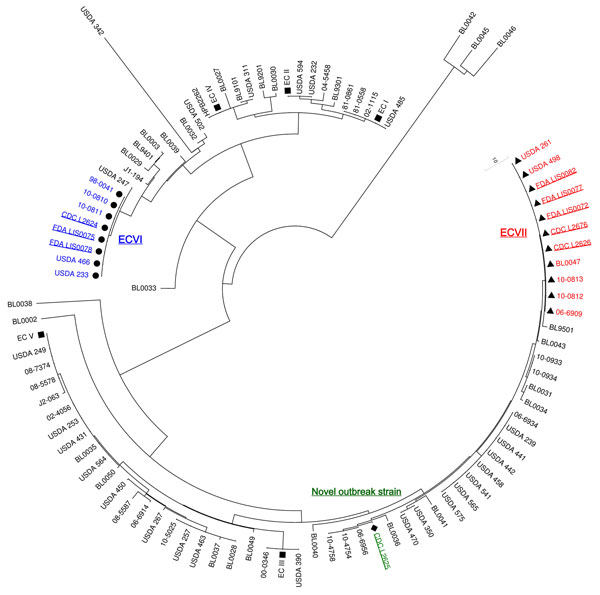Volume 19, Number 1—January 2013
Dispatch
Novel Epidemic Clones of Listeria monocytogenes, United States, 2011
Figure 2

Figure 2. . . Unrooted neighbor-joining tree computed in MEGA 5.0 (10) for multivirulence locus sequence typing data based on sequencing of 6 virulence genes, prfA, inlB, inlC, dal, clpP, and lisR (3) obtained for the 93 Listeria monocytogenes isolates compared in this study. Nine cantaloupe-associated outbreak isolates were from the Centers for Disease Control and Prevention (CDC) (GenBank accession nos. JQ407055–JQ407078) and the Food and Drug Administration (FDA) (JX141237–JX141275), 23 isolates from Knabel et al., 2012 (4), 29 isolates from Chen et al., 2007 (3), 29 from Berrang et al., 2005 and 2010 (7,8) (JQ946653–JQ946836), and 3 other isolates for which sequence data were available in GenBank. Squares indicate reference strains representing the 5 currently known L. monocytogenes epidemic clones. Underlined text indicates CDC and FDA isolates associated with the isolates from the 2011 cantaloupe-associated outbreak. Circles indicate strains classified as epidemic clone (EC)VI (indicated in blue). Triangles indicate strains classified as ECVII (indicated in red). Diamond indicates the novel outbreak strain (indicated in green).
References
- Centers for Disease Control and Prevention. Multistate outbreak of listeriosis associated with Jensen Farms cantaloupe—United States, August–September 2011. MMWR Morb Mortal Wkly Rep. 2011;60:1357–8.PubMedGoogle Scholar
- Cheng Y, Siletzky R, Kathariou S. Genomic divisions/lineages, epidemic clones, and population structure. In: Liu D, editor. Handbook of Listeria monocytogenes. Boca Raton (FL): CRC Press; 2008. p. 337–57.
- Chen Y, Zhang W, Knabel SJ. Multi-virulence-locus sequence typing identifies single nucleotide polymorphisms which differentiate epidemic clones and outbreak strains of Listeria monocytogenes. J Clin Microbiol. 2007;45:835–46. DOIPubMedGoogle Scholar
- Knabel SJ, Reimer A, Verghese B, Lok M, Ziegler J, Farber J, Sequence typing confirms that a predominant Listeria monocytogenes clone caused human listeriosis cases and outbreaks in Canada from 1988–2010. J Clin Microbiol. 2012;50:1748–51. DOIPubMedGoogle Scholar
- Verghese B, Lok M, Wen J, Alessandria V, Chen Y, Kathariou S, comK prophage junction fragments as markers for Listeria monocytogenes genotypes unique to individual meat and poultry processing plants and a model for rapid niche-specific adaptation, biofilm formation, and persistence. Appl Environ Microbiol. 2011;77:3279–92. DOIPubMedGoogle Scholar
- Ragon M, Wirth T, Hollandt F, Lavenir R, Lecuit M, Le Monnier A, A new perspective on Listeria monocytogenes evolution. PLoS Pathog. 2008;4:e1000146. DOIPubMedGoogle Scholar
- Berrang ME, Meinersmann RJ, Frank JF, Smith DP, Genzlinger LL. Distribution of Listeria monocytogenes subtypes within a poultry further processing plant. J Food Prot. 2005;68:980–5 .PubMedGoogle Scholar
- Berrang ME, Meinersmann RJ, Frank JF, Ladely SR. Colonization of a newly constructed commercial chicken further processing plant with Listeria monocytogenes. J Food Prot. 2010;73:286–91 .PubMedGoogle Scholar
- Halpin JL, Garrett NM, Ribot EM, Graves LM, Cooper KL. Re-evaluation, optimization, and multilaboratory validation of the PulseNet-standardized pulsed-field gel electrophoresis protocol for Listeria monocytogenes. Foodborne Pathog Dis. 2010;7:293–8. DOIPubMedGoogle Scholar
- Tamura K, Peterson D, Peterson N, Stecher G, Nei M, Kumar S. MEGA5: molecular evolutionary genetics analysis using maximum likelihood, evolutionary distance, and maximum parsimony methods. Mol Biol Evol. 2011;28:2731–9. DOIPubMedGoogle Scholar
- Farber JM, Daley EM, MacKie MT, Limerick B. A small outbreak of listeriosis potentially linked to the consumption of imitation crab meat. Lett Appl Microbiol. 2000;31:100–4. DOIPubMedGoogle Scholar
- Pagotto F, Ng L-K, Clark C, Farber J. Canadian listeriosis reference service. Foodborne Pathog Dis. 2006;3:132–7. DOIPubMedGoogle Scholar
- Orsi RH, Borowsky ML, Lauer P, Young SK, Nusbaum C, Galagan JE, Short-term genome evolution of Listeria monocytogenes in a non-controlled environment. BMC Genomics. 2008;9:539. DOIPubMedGoogle Scholar
- Pan Y, Breidt F Jr, Kathariou S. Competition of Listeria monocytogenes serotype 1/2a and 4b strains in mixed-culture biofilms. Appl Environ Microbiol. 2009;75:5846–52. DOIPubMedGoogle Scholar
- Laksanalamai P, Joseph LA, Silk BJ, Burall LS, Tarr CL, Gerner-Smidt P, Genomic characterization of Listeria monocytogenes strains involved in a multistate listeriosis outbreak associated with cantaloupe in US. PLoS ONE. 2012;7:e42448. DOIPubMedGoogle Scholar